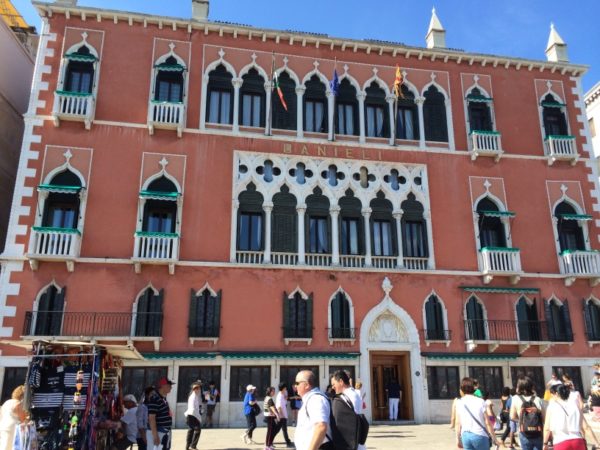An In-Depth Look At The Competing Forces In The Marriott Acquisition Of Starwood

As we head down the final stretch before Marriott integrates the Starwood Preferred Guest program with Marriott Rewards, much has been written about how we got here. There have been plenty of worries on the part of SPG loyalty members. For the most part, I haven’t heard too many complaints from Marriott Rewards members. To say that one side or the other got the better end of the deal ignores the fact that there were a lot more stakeholders at the table beside loyalty members. And, that for large parts of the discussion, loyalty members weren’t the most important element being considered.
Patrick Clark has written an excellent piece for Bloomberg that dives in deeply on the process that has led to one program for Marriott and SPG (and Ritz-Carlton). The article starts out with a description of a couple enjoying a luxurious vacation at St. Regis Maldives using their SPG points. However, it doesn’t take long for Patrick to outline all of the competing forces in bringing this acquisition to a successful conclusion.
Diacre, 41, travels at least 100 nights in a typical year, and for the most part he chooses Starwood, even when nicer or more convenient lodgings are available. “I remember going to Detroit, and my colleagues were staying five minutes away from the client site,” he says. “I was staying 20 minutes away, and, by the way, with traffic it was more like an hour.” The points were worth the inconvenience.
That type of behavior was a big reason Marriott International Inc. paid $13.6 billion to acquire Starwood Hotels & Resorts Worldwide LLC in September 2016 in a deal that created a hospitality industry behemoth that today has 1.3 million rooms and 110 million loyalty program members.
The hotel and airline industries built their membership programs to encourage irrational loyalty like what’s described above. I’ve been guilty of it many times. Marriott saw how fiercely loyal SPG members were to the brand. They were willing to pay for that, but they needed to make sure they could actually keep the customers they were acquiring. And, Marriott wasn’t exactly known for handsomely rewarding their best customers.
Enter Hotel Owners
Marriott doesn’t own most of their hotels. Neither does Starwood. That means there’s another very important stakeholder to satisfy at the bargaining table:
Hotel companies are constantly jostling with owners over operating issues, whether big strategic matters such as brand segmentation or local concerns including the size of the television screens in guest rooms and the amount of laundry detergent that goes in a load of linens. Buying Starwood had made Marriott harder to resist—for owners and guests alike—but it left the company with a series of trade-offs. Cut perks, and SPGers might balk; expand them too much, and owners might go looking for new flags to fly.
“It’s sort of like a negotiation,” says Chad Crandell, chief executive officer of CHMWarnick LLC, a hotel investment adviser. “If both sides leave and no one is happy, then it’s probably a good program.”
I don’t like Mr. Crandell’s assertion that if both sides leave unhappy, it’s probably a good program. But, I do understand the constraints behind trying to make everyone happy. It’s a lot harder for a hotel to change their flag. When they do it’s a noticeable loss for the hotel chain. It can also be a loss for members. A balancing act with many different ropes to traverse. How to keep those members engaged while keeping beautiful properties like the Danieli to serve those members?
The Final Two Pennies
I really enjoyed Patrick’s take on the Marriott acquisition of SPG. And, not just because he quoted me saying that Marriott members have Stockholm syndrome (I still believe that). I’ve written most of my pieces from a customer’s perspective or from a management perspective. Most of the pieces I’ve seen from fellow bloggers fall into those two avenues as well. This piece does a solid job folding in the levels of complexity a move this big involves. We still don’t know what happens on August 18th. But, we’re a bit less scared of the future.
The post An In-Depth Look At The Competing Forces In The Marriott Acquisition Of Starwood was published first on Pizza in Motion


A very thorough and balanced look at the merger and it’s underlying loyalty implications. What has struck me thoroughout the process is the fact that Marriott totally ignored a certain type of traveler profile in the new program. Namely , the high rate / high spend guest. Marriott has no path to top tier status via spend . Hilton and Hyatt both have a way to top tier based on spend alone. It is amazing to think that Marriott is consciously foregoing high rate guests. In the new program , you can spend 40 nights and 20,000 dollars but only get rewarded with useless Gold status. I assume that Hyatt and Hilton are aware of this omission and would be happy to have the “left out” in their Park HyattWaldorf/Conrad properties.
Maxie Dean, it’s a good point. High spend customers are the ultimate goal of the hotel chains. And, Marriott is indicating they want high rates by slapping a $20K spending requirement to get an Ambassador.
For $20000 they need to be delivering , big time, on the metaphorical pound of flesh. I share David Heyman’s skepticism. Marriott had to be dragged ,screaming and kicking ,to the granting of Platinum Premier status to SPGers with 750 plus nights. As a consequence,I maintain a deep and abiding suspicion of Marriott and their intentions.
Paolo, couldn’t agree more on the $20K. I won’t have that much spend. But, if I did, I’d want some solid assurances that the service would be at least as good as it is now, if not better.
Paolo, I’m proceeding with caution as well.
Good post and an interesting article. I’m one of the aforementioned SPG loyalists. When I see the moves that Marriott has made, I’m extremely skeptical about the future of the program. We’ll see.
Christian, I’m in the same boat. Watching Marriott (seemingly) begrudgingly make changes like late check-out and lifetime status have me a bit concerned for the future. But, we’ll see.
Indeed , the success of the program will be dependent on the delivery of promised benefits . I am very curious to see how the suite upgrades are processed in cities such as DC, NYC , BOS , LA , SF , London , Paris , Tokyo etc. I hope that those entitled to suite upgrades get them with minimum hassle. SPG was very good at delivering the promised benefits . We will have to wait and see .
Maxie, I fear it will be a lot like when UA and CO combined. Too many elites chasing too few upgrades.